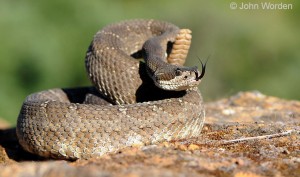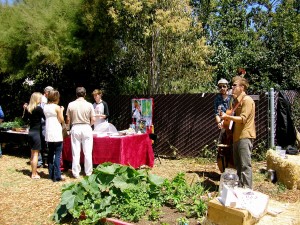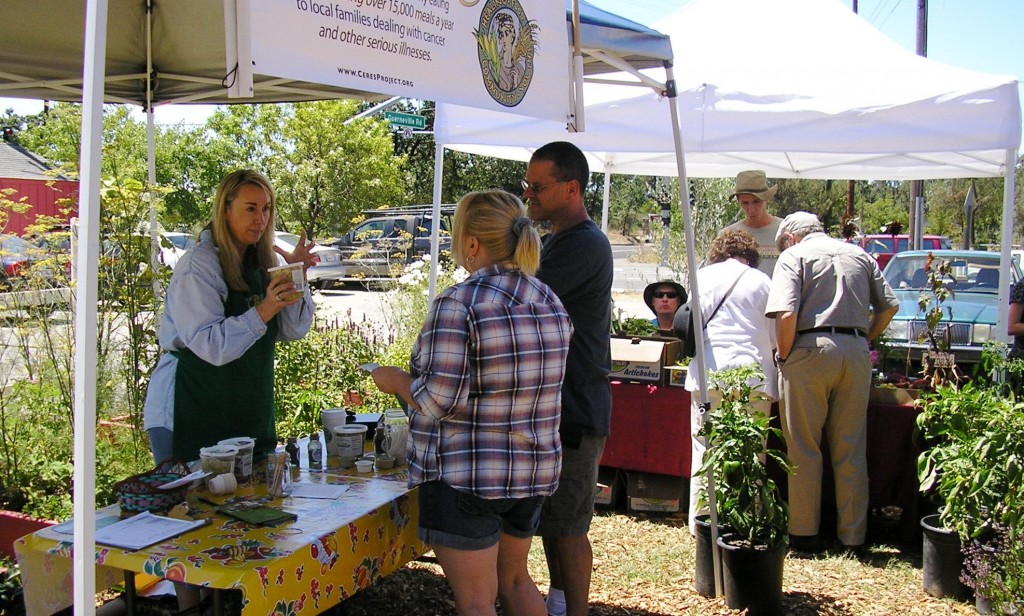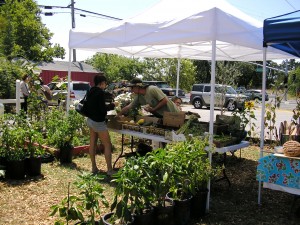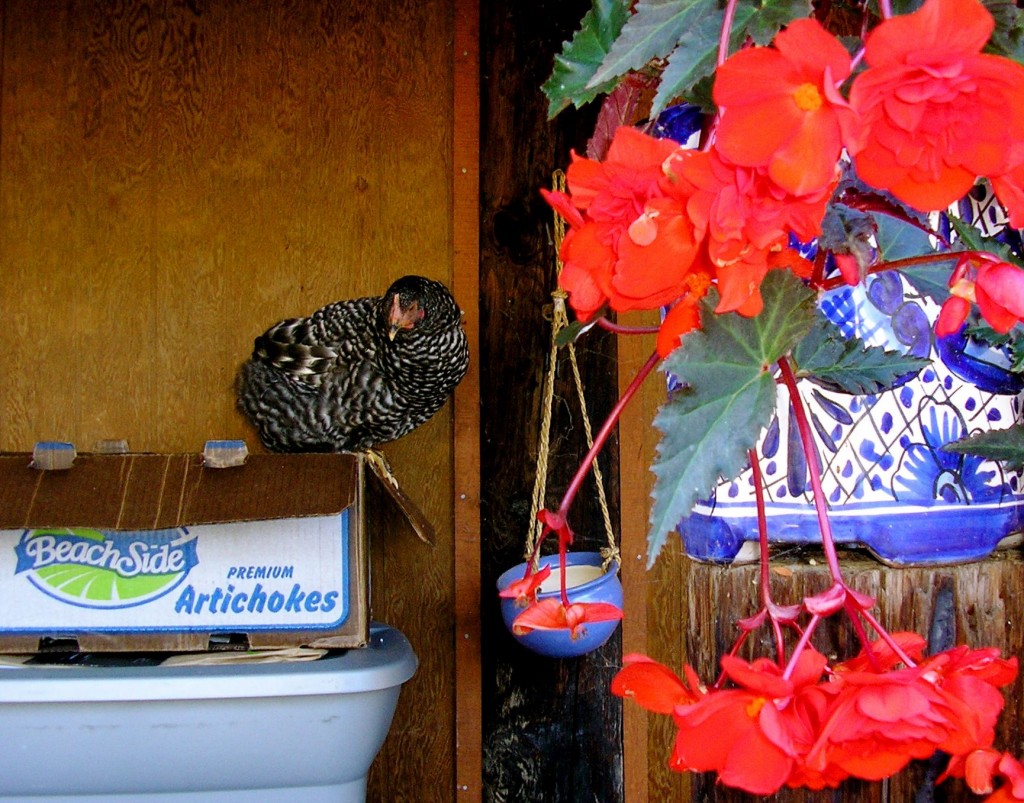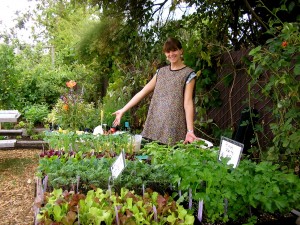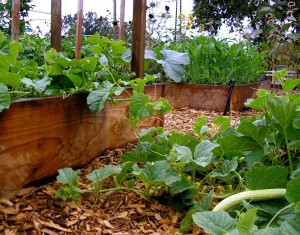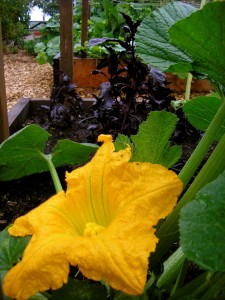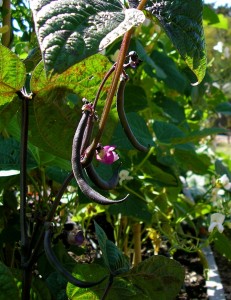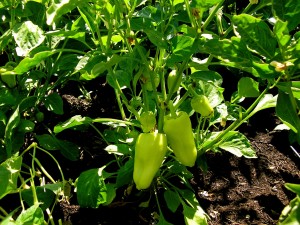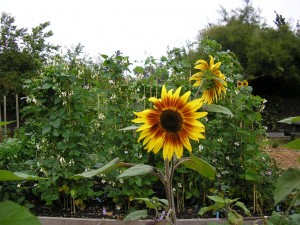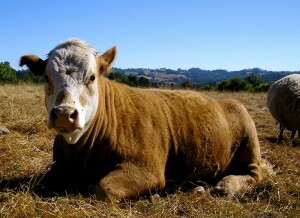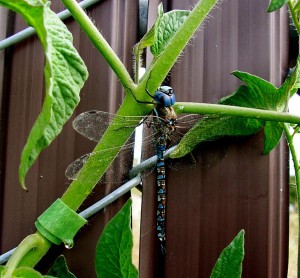On the way down from Gunsight Rock last Sunday I came quite close to stepping on a large rattlesnake. The rattler was stretched across the trail and had I taken another step or two I would have certainly been bitten. According to Sonoma County Reptile Rescue, Northern Pacific Rattlesnakes are the only species that reside in Northern California. This deadly pit viper likes to burrow in caves and rock crevices, sometimes with other snake species. The Goodspeed trail to Gunsight rock is one of the most beautiful and rugged hikes in the county. We were lucky to have excellent visibility with views of San Francisco, Mt. Tam and the lovely Sonoma Valley.
Page 7 of 12
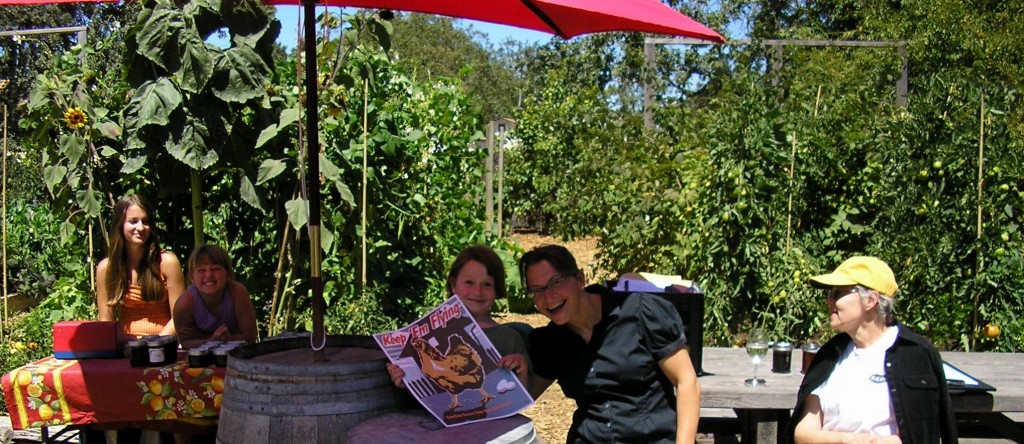
Chef Duskie Estes with her mother Carol, daughters Mackenzie and Brighty, and Ziggy's daughter Teal. Mackenzie is holding up a Victory Garden Poster she just bought.
We all had fun at the Sunshine Preserves Farm Stand last Saturday. Ty was back with more beautiful organic produce, and the Easy Leaves played an amazing acoustic set. My sister Sarah ran our workshop table. This weekend will be a workshop on how to plant a vegetable garden now that will provide fresh produce through the winter. We will have a demonstration on how to build a mini-greenhouse, and have handouts on the best veggies to grow in winter. The farm stand is at the restaurant, 3535 Guerneville rd.
Here is the text of Sarah’s sunshine preserves hand-out:
TOO MUCH FRUIT?
Peaches and Apricots: Sunshine Preserves, Frozen slices (very lightly sugared), Dried, Low-sugar jam using commercial pectin, Chutney, Leather
Plums: Sunshine Preserves, Dried, Jam, Leather
Prunes and Figs: Dried
Apples: Applesauce, Apple butter, Dried, Frozen, uncooked pies, Cider, chutney
Sour Cherries: Freeze whole with very light addition of sugar, Jam
Blueberries: Freeze whole, Jam
Raspberries, blackberries, boysenberries: Freeze whole on cookie sheet then pour into a plastic bag, Sunshine Preserves, Jam, Frozen, uncooked pies, Leather
Pears: Pear Butter, Chutney
Quince: Jelly, Chutney, Cooked until tender and frozen, Leather
Grapes: Jelly, Juice, Dried (raisins)
Persimmons: Frozen, Dried, Leather
NOTE: The interior of a car with the windows just cracked is a great place to dry fruit and vegetables, fruit leather and cook Sunshine Preserves.
SUNSHINE PRESERVES
Peel and slice fruit, if necessary. Add ¼ cup sugar to each cup of fruit. Stir well and allow to sit for ½ hour to release the juice. Place in a large shallow pan, bring to a full boil stirring constantly, allow to cool and partially cover with cling wrap and place in sunny place. Stir several times per day. When thick, bring back to a boil and pour into hot sterilized containers, seal. Refrigerate after opening. If the nights are cloudy bring inside and take back outside when warm again.
PUNA’S CHUTNEY (for apples, pears, quince)
10 lbs Sliced Fruit 1 Pkg Currants 2 Heads Garlic
10 lbs Sugar (half brown) 6 Tbs. Ginger root, peeled&minced 4 Tbs. Dr. Chile Peppers
2 Pkg. Sultana Raisins 2 Quarts White vinegar 2 Tbs. Salt
Bring vinegar and sugar to a full boil, continue for 10 minutes, add raisins, currants, garlic, chile peppers, fruit, salt and ginger. Cook at a simmer for one hour. Put in hot sterilized jars and seal.
Our Tomato Workshop was so well received that we have decided to host a workshop each Saturday in August. This weekend we are hosting a Sun Preserves Workshop. We were excited to welcome Ty Taube to his first farmstand, he brought a bounty of hand grown chemical free produce. Ty, along with being a superb gardener, is also a cook and has supplied zazu with veggies when they were out. He grows with a friend on Scenic drive in Santa Rosa. My sister Sarah ran the booth selling veggie and herb starts, backyard veggies, and berries from Sonoma Swamp Blues. I will be planting many of the starts that we did not sell at the Living Room Center, where I will be working with the kitchen to develop recipes and harvesting plans. We also welcomed the Ceres Project booth, staffed by Kristie and Ruby. See the post below for Maile’s lecture handout.
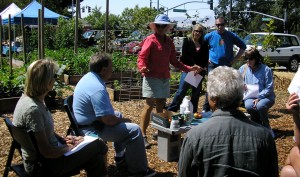
Maile speaking with some examples of fertilizer options on the table. As usual she was filled with infectious enthusiasm.
Maile’s tomato talk captivated a small but attentive crowd at our first zazu farmstand market. Here is the text of her talk:
GROWING TOMATOES by Maile Arnold
Types of tomatoes: Determinate and Indeterminate Determinate varieties of tomatoes, also called “bush” tomatoes, are varieties that are bred to grow to a compact height (approx. 4 feet). They stop growing when fruit sets on the terminal or top bud, ripen all their crop at or near the same time (usually over a 2 week period), and then die. They may require a limited amount of caging and/or staking for support, should NOT be pruned or “suckered” as it severely reduces the crop, and will perform relatively well in a container (minimum size of 5-6 gallon). Examples are: Rutgers, Roma, Celebrity (called a semi-determinate by some), and Marglobe. Indeterminate varieties of tomatoes are also called “vining” tomatoes. They will grow and produce fruit until killed by frost and can reach heights of up to 10 feet although 6 feet is considered the norm. They will bloom, set new fruit and ripen fruit all at the same time throughout the growing season. They require substantial caging and/or staking for support and pruning and the removal of suckers is practiced by many but is not mandatory. Examples are: Big Boy, Beef Master, most “cherry” types, Early Girl, most heirloom varieties, etc.
Heirloom and Hybrid: Heirloom tomatoes come true from seed while hybrids do not. Tomatoes are tropical plants and do not like cold nights. They will be stressed and thus more susceptible to disease. My rule of thumb is after Mother’s Day. I only grow indeterminate tomatoes and like to train them on 4” hog wire so they are very two dimensional. Most of the suckers are removed so that there are 4 main canes with short side shoots. The leaves receive maximum sun and air circulation thus reducing disease. The fruit is easy to pick.The alternative is to cage the plants.Starting seeds: I start seeds that I have saved from the earliest and best tomatoes from the year before. I plant them in flats and transplant to deep paper cups (Vente latte cups) that have holes punched in the bottom. I put the seedling low in the cup and backfill with potting soil as the plant grows. The stem will sprout roots and the plant will have a healthy root system. The cup is easily labeled. When planting, I tear off the bottom and pull apart the side seam and leave the cup close by for ID. I like to start seeds by April 1st. After planting, the plants can be covered with Frostguard Row Cover or surrounded by 1 gallon jugs filled with water for protection from the cool nights.
Saving seeds: I smear the seeds on newspaper so that there is only 1 layer, label and allow to dry. The following year the paper can be torn and planted (think seed tape)
Dealing with the bounty: I blend the tomatoes and cook them to reduce by ½ then can or freeze the sauce. To dry, remove a strip of skin and then slice. Put them on racks in the back of the car, crack the windows and park in the sun. Remove when leathery and seal tightly.
Sources for seed: Superseeds.com, Internet
Sources for plants: Harmony Farm Supply, Oldies and Goodies (sold at Bassignani and Andy’s)
Armenian cucumbers are extremely productive plants. If I don’t harvest this plant every other day, the cucumbers become enormous. I have found that the trick to growing cucumbers is making sure they have even moisture, a rich soil and good drainage.
The white corn in the background is a soil experiment. The plants are growing in half compost and half manure. They seem to be doing well so far, though too much organic matter can cause fungal problems in the soil. My hypothesis is that if you don’t over water, that you can get away with growing vegetables in pure organic matter. After all vegetables evolved as “camp followers”, meaning they emerged out of the food scrap piles of ancient nomadic tribes in Europe and elswhere.
I have been harvesting the bush beans at zazu several times a week. We have Roma, Yellow Wax and Royal Burgundy. It is fun to search for hidden beans and bring them to the restaurant walk-in. The kitchen usually cooks or pickles these beans, though they are sweet and crunchy fresh. It is really exciting to be a part of a top notch restaurant kitchen, though I am constantly humbled by the mastery of sous chefs Tara Wachtel and Gabe Nahas.
In so many jobs you can get away with moving slow and slacking, but not in a restaurant kitchen. Everyone has a sense of hustle and it’s fascinating to watch how the food flows from farm to plate. The peppers will go on the menu this week. We have Anaheim/Conquistador, Padron, and Round of Hungary. Tara is excited about frying them, but she made sure that I didn’t plant any really spicy ones, since they don’t pair well with wine.
Duskie gave me the seeds for these gigante beans in April and I planted them in 2 beds at zazu. I spent a lot of time mixing compost and oyster shells into the soil. This hard work paid off as the beans ran quickly up the bamboo supports I gave them.
Clifford is an agreeable hereford. He has lived at Rancho Pillow for about a year now and has enjoyed a gourmet diet of grasses, legumes, garden trimmings, and large zucchinis. Like Dave, the angus steer who came before him, I expect Cliff will be flavorful and tender.
We are in the process of installing 4 large rainbird sprinklers to irrigate the pasture so that Cliff and his sheep pals have green grass all year round. We used 1+1/4″ poly pipe which is easy and quick to install.
As I pruned the tomatoes at zazu this morning I discovered a captivating blue dragonfly. This magnificent insect was motionless, which led me to assume that it had already mated and was waiting to die. Organic and conventional pesticides can harm insects like dragonflies, so my goal is to use none. Healthy plants, like healthy people, don’t get sick very often. If I provide plants with a balanced diet of nutrients and water, they will possess a natural resistance to pests and disease. I readily admit that our squash has some aphids, but they don’t affect the quality of the produce. I would much rather enjoy the aesthetic and practical benefits of beneficial insects like dragonflies than have a bug-free garden.
